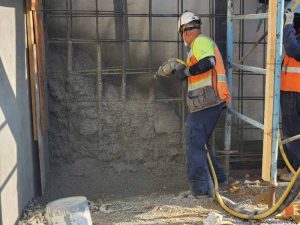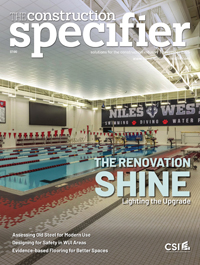Mastering blindside waterproofing: A proactive, integrated approach

The geotechnical report also typically indicates the existence of soil or groundwater mineralogical attributes such as iron ochre (also called iron bacteria), or hazardous contaminants which may classify the area as a “brownfield site.”4 Many contaminants found at brownfield sites, such as laundromat chemicals, or oils from a former gas station (or associated hydrocarbons), can degrade an improperly selected waterproofing membrane or accessory materials, such as tapes and sealants, and the contaminants (subject to local regulations) may require the use of specialized membranes which function as a gas barrier for the below-grade enclosure. If iron ochre is found at the site (a scenario the authors have seen occur in the Washington, D.C. area for example), its presence can clog or diminish the water flow of subgrade drainage piping over time, necessitating frequent cleaning of the drainage lines in service. Further, if the geotechnical site investigation identifies other geotechnical conditions (e.g. expansive soils), additional considerations may affect or preclude the viability of an under-slab drainage system.
Concrete placement method and formwork/reinforcement materials
Shotcrete
Project teams often elect to utilize the cast-in-place concrete placement method for below-grade foundation structures, but in some U.S. regions, they either favor or increasingly consider the shotcrete method (Figure 4). Shotcrete is a pneumatically applied concrete mix fired against the blindside waterproofing membrane at a high speed of approximately 19 to 30 m/s (65 to 100 ft/s),5 and the use of shotcrete demands coordination with the blindside waterproofing design. Some shotcrete/blindside waterproofing considerations include the following:
- The shotcrete application can cause waterproofing membrane seam blowout failure or puncture the blindside membrane due to the velocity of the aggregate projection.
- The rebar cage requires stabilization to the SOE, and in some cases, stabilization anchors remain as permanent penetrations in the blindside waterproofing, requiring treatment with appropriate flashing details. For similar reasons as the shear studs between soldier piles and the building foundation discussion, these penetrations tend to increase performance vulnerability for the waterproofing system.
- Concrete overspray (i.e. when concrete splatter from the shotcrete application lands on an adjacent piece of membrane and cures before that portion of the wall is placed) can detrimentally affect the bond of the shotcrete to the waterproofing; this bond is necessary for most blindside waterproofing membranes to resist the lateral migration of water as intended.
- “Shadowing” (i.e. thin areas and voids) around dense areas of rebar, can affect the structural quality of the wall placement and can be detrimental to concrete-to-membrane bond (refer to the lateral migration resistance discussion).
- Many blindside waterproofing membranes require the sustained confining pressure to perform as intended,6 and improper shotcrete execution can result in inadequate or non-uniform confining pressure.
Based on these potential pitfalls, waterproofing manufacturers may not authorize the use of shotcrete with some of their blindside waterproofing products, or they may only authorize their use at limited instances (e.g. non-hydrostatic applications). Waterproofing manufacturers also typically have enhanced detailing requirements, such as more robust seam reinforcement than standard details, when shotcrete is utilized. Some waterproofing manufacturer’s market-specific systems are tailored for the shotcrete application.








